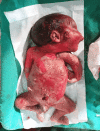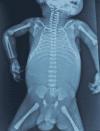Adverse Perinatal Outcomes of True Knot of the Umbilical Cord: A Case Series and Review of Literature
- PMID: 35989783
- PMCID: PMC9385408
- DOI: 10.7759/cureus.26992
Adverse Perinatal Outcomes of True Knot of the Umbilical Cord: A Case Series and Review of Literature
Abstract
A true knot of the umbilical cord (TKUC) is an actual knot formed in pregnancy. It is seen in approximately 0.3%-1.2% of all pregnancies. True knots are of significance as they can cause a wide spectrum of adverse perinatal outcomes like small for gestational age (SGA) fetus, low appearance, pulse, grimace, activity, and respiration (Apgar) score at birth, fetal hypoxia, and even fetal demise. Here, we report a case series of three patients with TKUC and the varied adverse perinatal outcomes associated with them. A low-risk primigravida at term gestation had a suspicious non-stress test (NST). Repeat NST after maternal resuscitation became pathological. Emergency cesarean delivery was performed in view of pathological NST persisting despite intrauterine resuscitation. A healthy male baby weighing 2920 g was delivered, and the umbilical cord had a true knot. A multigravida at 33 + 3 weeks of gestation was referred with fetal growth restriction (FGR). Color Doppler examination showed absent end-diastolic flow (AEDF) in the umbilical artery (UA). Cesarean delivery was performed in view of FGR stage two with AEDF in the UA at 34 weeks of gestation as per the Barcelona criteria. A male baby weighing 1505 g was delivered. The umbilical cord had a true tight knot. The baby had an Apgar score of 7 at one minute after birth but was shifted to the neonatal intensive care unit (NICU) in view of low birth weight and prematurity. The baby slowly gained weight and was discharged from NICU after 15 days in stable condition. A multigravida at 32 weeks of gestation was referred with intrauterine fetal demise. Ultrasonography confirmed the presence of a single intrauterine dead fetus corresponding to 30 + 4 weeks of gestation with an estimated fetal weight (EFW) of 1633 g, amniotic fluid index (AFI) equal to nine, and presence of Spalding's sign. Induction of labor was done, and she expelled a dead macerated male fetus weighing 1825 g. The infantogram was normal. A true umbilical cord knot was found. The umbilical cord is the source of fetal blood supply; therefore, any cord abnormality can have a significant impact on the fetal outcome. There are various factors that can predispose to TKUC, such as polyhydramnios, increased cord length, monoamniotic twins, male baby, grand multiparity, small fetus, and amniocentesis. TKUC can lead to various adverse outcomes in pregnancy and labor like SGA fetus, low Apgar score at birth, fetal hypoxia, and fetal demise. TKUC increases the risk of fetal demise by as much as four times. With the development of advanced techniques such as three-dimensional/four-dimensional color Doppler ultrasounds, TKUC can be diagnosed antenatally in the form of a four-leaf-clover, a "hanging-noose sign," or by an unusual multicolor pattern in the cord. The prenatal detection rate of TKUC is only 12%. It mostly remains undetected unless visualized incidentally. Although TKUC is not rare and can have serious outcomes, the importance of its antenatal diagnosis has not been determined. It should be suspected in patients with risk factors, and emphasis should be placed on its antenatal diagnosis on ultrasonography to avoid obstetric disasters in otherwise low-risk females. Though there is no specific management of these cases, a good clinical outcome can be achieved if TKUC is diagnosed antenatally and monitored closely until fetal maturity is attained.
Keywords: adverse perinatal outcomes; human umbilical cord; perinatal mortality; perinatal outcome; true knot.
Copyright © 2022, Agarwal et al.
Conflict of interest statement
The authors have declared that no competing interests exist.
Figures








Similar articles
-
True Knot of the Umbilical Cord and Associated Adverse Perinatal Outcomes: A Case Series.Cureus. 2023 Feb 23;15(2):e35377. doi: 10.7759/cureus.35377. eCollection 2023 Feb. Cureus. 2023. PMID: 36987486 Free PMC article.
-
The perils of true knot of the umbilical cord: antepartum, intrapartum and postpartum complications and clinical implications.Arch Gynecol Obstet. 2022 Mar;305(3):573-579. doi: 10.1007/s00404-021-06168-7. Epub 2021 Aug 17. Arch Gynecol Obstet. 2022. PMID: 34405285
-
Adverse Perinatal Outcomes Associated with True Knot of the Umbilical Cord: A Multicenter Retrospective Study.Am J Perinatol. 2025 Mar 29. doi: 10.1055/a-2553-9200. Online ahead of print. Am J Perinatol. 2025. PMID: 40064311
-
True knot of umbilical cord: Case report and review of literat.J Pak Med Assoc. 2016 Aug;66(8):1037-8. J Pak Med Assoc. 2016. PMID: 27524546 Review.
-
Ultrasound in twin pregnancies.J Obstet Gynaecol Can. 2011 Jun;33(6):643-656. doi: 10.1016/S1701-2163(16)34916-7. J Obstet Gynaecol Can. 2011. PMID: 21846456 Review.
Cited by
-
True umbilical cord knot detection via active scanning: a prospective study on accuracy and visualization factors.BMC Pregnancy Childbirth. 2025 Apr 28;25(1):514. doi: 10.1186/s12884-025-07629-6. BMC Pregnancy Childbirth. 2025. PMID: 40295954 Free PMC article.
-
The benefit of active management in true knot of the umbilical cord: a retrospective study.Arch Gynecol Obstet. 2024 Jul;310(1):337-344. doi: 10.1007/s00404-024-07568-1. Epub 2024 Jun 3. Arch Gynecol Obstet. 2024. PMID: 38829389 Free PMC article.
-
Double true umbilical cord knots coexisting with a nuchal cord with successful fetal outcome: A case report.SAGE Open Med Case Rep. 2024 Mar 15;12:2050313X241239524. doi: 10.1177/2050313X241239524. eCollection 2024. SAGE Open Med Case Rep. 2024. PMID: 38495733 Free PMC article.
-
Antenatal Diagnosis of a True Knot of the Umbilical Cord: A Rare Case With a Successful Surgical Outcome.Cureus. 2025 Jun 15;17(6):e86095. doi: 10.7759/cureus.86095. eCollection 2025 Jun. Cureus. 2025. PMID: 40671969 Free PMC article.
-
True Knot of the Umbilical Cord and Associated Adverse Perinatal Outcomes: A Case Series.Cureus. 2023 Feb 23;15(2):e35377. doi: 10.7759/cureus.35377. eCollection 2023 Feb. Cureus. 2023. PMID: 36987486 Free PMC article.
References
-
- True or false umbilical cord knot? Differentiation via 3D/4D color Doppler ultrasound. Merz E, Pashaj S. Ultraschall Med. 2018;39:127–128. - PubMed
-
- Placenta and umbilical cord abnormalities seen with stillbirth. Pinar H, Carpenter M. Clin Obstet Gynecol. 2010;53:656–672. - PubMed
-
- Prenatal ultrasound diagnosis and pregnancy outcome of umbilical cord knot - debate regarding ethical aspects of a series of cases. Bohîlțea R, Turcan N, Cîrstoiu M. http://www.ncbi.nlm.nih.gov/pmc/articles/PMC5154319. J Med Life. 2016;9:297–301. - PMC - PubMed
-
- Risk factors associated with true knots of the umbilical cord. Hershkovitz R, Silberstein T, Sheiner E, Shoham-Vardi I, Holcberg G, Katz M, Mazor M. Eur J Obstet Gynecol Reprod Biol. 2001;98:36–39. - PubMed
Publication types
LinkOut - more resources
Full Text Sources
Miscellaneous
